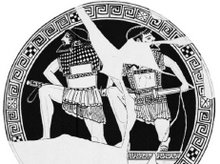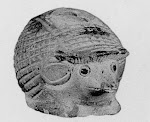but it is significant."
 This is an advantage. I need to address it specifically because resting the shield on the shoulder has has been put forth by the pro-othismos (pushing match) authors to partially explain why the shield has its characteristic concave shape. Once I am finished presenting my new model for othismos in the next few posts, I will have to deconstruct the current, incorrect pro-othismos arguments. The development of the double-grip as a means of bearing the weight of the shield I will adress in coming posts, because it is tied to the shield's true function, but I'll discuss the idea of the rim as a shoulder-rest.
This is an advantage. I need to address it specifically because resting the shield on the shoulder has has been put forth by the pro-othismos (pushing match) authors to partially explain why the shield has its characteristic concave shape. Once I am finished presenting my new model for othismos in the next few posts, I will have to deconstruct the current, incorrect pro-othismos arguments. The development of the double-grip as a means of bearing the weight of the shield I will adress in coming posts, because it is tied to the shield's true function, but I'll discuss the idea of the rim as a shoulder-rest.The apis can be rested on the shoulder. The logic behind citing this as a reason for the concavity and rim is as follows. The aspis is heavy and held in a double-grip that does not allow it to be put down easily, so a rim was added to allow it to be rested on the shoulder. There are problems with this logical progression.
The aspis is heavy, but much of the weight is added by the thickest part of the shield, which is the thickened shoulder section near the edge and the off-set rim. Thus the means of carrying the weight is responsible for a good portion of it.
Throughout Greek history we see many heavy shields. Large Mycenaean shields appear to have aided in carrying this weight by the use of a shoulder-strap or telamon. The smaller, but still robust shields of the later Macedonians is also equipped with a shoulder-strap. Were bearing the weight of a heavy shield the only concern, the use of a simple strap makes far more sense than an unique, heavy shoulder rest rim structure. Resting the shield on the shoulder is surely something hoplites did to bear its weight, but this function arose as a consequence of the heavy, offset rim, not as its source.
 As an analogy I put forward the wearing of corinthian helmets pushed back off the face and held in place by its cheek-pieces. In high school we used to wear our football helmets in this way whenever possible because, even with modern ventilation systems, the difference in heat is enormous. No one would suggest that the cheek-pieces evolved in order to be worn in this manner, the protective function to the face and neck is obvious. It is only the fact that the benefit of the aspis' unique shape is not obvious that allows such conjecture.
As an analogy I put forward the wearing of corinthian helmets pushed back off the face and held in place by its cheek-pieces. In high school we used to wear our football helmets in this way whenever possible because, even with modern ventilation systems, the difference in heat is enormous. No one would suggest that the cheek-pieces evolved in order to be worn in this manner, the protective function to the face and neck is obvious. It is only the fact that the benefit of the aspis' unique shape is not obvious that allows such conjecture.As an aside there is an excellent reminder of the power of fashion in the design of military equipment. In Italy, magna graecia, we see a type of helmet known as the Italo-corinthian that is designed to look like a corinthian helm worn in this way, but cannot be worn pulled down. There is no functional reason for this, the faux eye-slits surely weaken the structure, but the force of fashion is strong.






5 comments:
Very interesting, thanks.
You're welcome. Comments help me greatly to clarify what is presented.
An informative post..please write more as the information you provide is rather lacking elsewhere.
Thanks for the nudge, I'll complete this thread soon. My work keeps getting in the way. I'm glad that you find it useful.
Great read thank yoou
Post a Comment